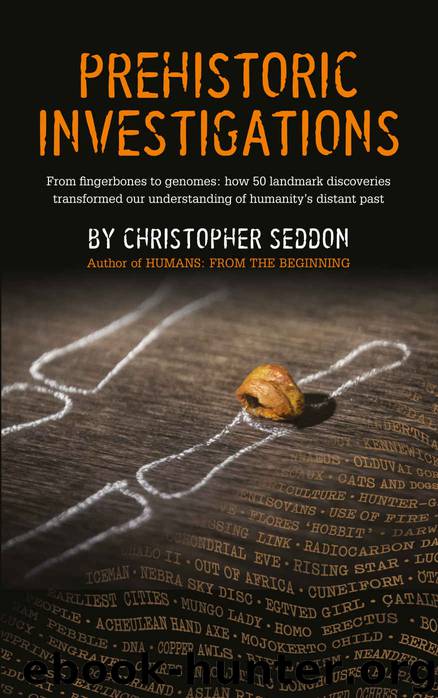Prehistoric Investigations: From Denisovans to Neanderthals; DNA to stable isotopes; hunter-gathers to farmers; stone knapping to metallurgy; cave art to stone circles; wolves to dogs by Christopher Seddon

Author:Christopher Seddon [Seddon, Christopher]
Language: eng
Format: epub
Tags: Anthropology, Archaeology, Prehistory, Human evolution
ISBN: 9780992762056
Publisher: Glanville Publications
Published: 2016-02-23T05:00:00+00:00
31: Prime suspect
Were humans responsible for the Late Quaternary mass extinction?
Between 50,000 and 10,000 years ago, the Earth experienced a mass extinction event which devastated the megafauna of the Pleistocene world. Australia and the New World were hardest hit, but no habitable continent remained unscathed. In all, around 180 large mammal species and many giant flightless birds went extinct, including mammoths, mastodons and giant deer with antlers spanning 3 m (10 ft.). The Late Quaternary extinction event was one of the largest extinction events since the demise of the dinosaurs, and significantly it was the first to occur since the appearance of Homo sapiens. Its timing coincides suspiciously with the dispersal of our species around the world.
The extinction was first recognised by early geologists towards the end of the eighteenth century and by the early nineteenth century, two possible causes were being proposed as possible causes for the extinctions – climate change and human activity. The latter became popular after 1860, and humanity has been prime suspect ever since. The ‘overkill’ hypothesis put forward by geoscientist Paul Martin proposes that humans rapidly hunted the megafauna into extinction, killing them faster than they could breed. Other theories that implicate human activity emphasise habitat destruction as a result of land clearance, and the introduction of invasive predatory species.
There is no doubt that human activity since the last century has led to a dangerous loss of biodiversity. Theories that implicate humans in the Late Quaternary extinction event are understandably popular with environmental campaigners, who see it as a harbinger of worse to come if humanity does not mend its ways. Against this, it is argued that we cannot extrapolate such losses back to the Late Pleistocene without further evidence, or without considering alternatives such as the constant climate change that characterised the Pleistocene. Nineteenth century climate change theories were based around either sudden catastrophic deep freeze or drought, but modern hypotheses are based around break-up or disappearance of habitats, reduction in local plant diversity upon which large herbivorous mammals rely, and disruptions to the delicate equilibrium between plant and animal species in complex habitats.
A third possibility, which has gained traction in recent years, is that 12,900 years ago, the Earth suffered multiple impacts and airbursts from an asteroid or comet that had previously broken up in space. Though far less severe than the impact thought to have brought about the extinction of the dinosaurs, it was still sufficient to trigger an ‘impact winter’ that brought about the extinctions. The time of supposed impact corresponds to a period of cooling known as the Younger Dryas, but sceptics point out that this was probably caused by meltwater from the icecaps cutting off the Gulf Stream as temperatures rose in the latter part of the last Ice Age.
Despite innumerable studies worldwide, there is to this day very little consensus on the cause of the extinctions, or indeed if there was a single cause. Studies have tended to focus on obtaining extinction dates for various species of megafauna by determining just when they disappear from the fossil record.
Download
This site does not store any files on its server. We only index and link to content provided by other sites. Please contact the content providers to delete copyright contents if any and email us, we'll remove relevant links or contents immediately.
| Fossils | Game Theory |
| Genetics | Molecular Biology |
| Organic | Paleontology |
Sapiens: A Brief History of Humankind by Yuval Noah Harari(14057)
Sapiens by Yuval Noah Harari(5183)
Pale Blue Dot by Carl Sagan(4743)
Homo Deus: A Brief History of Tomorrow by Yuval Noah Harari(4733)
Livewired by David Eagleman(3575)
Origin Story: A Big History of Everything by David Christian(3532)
Brief Answers to the Big Questions by Stephen Hawking(3280)
Inferior by Angela Saini(3173)
Origin Story by David Christian(3059)
The Gene: An Intimate History by Siddhartha Mukherjee(2970)
Signature in the Cell: DNA and the Evidence for Intelligent Design by Stephen C. Meyer(2932)
The Evolution of Beauty by Richard O. Prum(2890)
Aliens by Jim Al-Khalili(2733)
How The Mind Works by Steven Pinker(2658)
A Short History of Nearly Everything by Bryson Bill(2539)
Sex at Dawn: The Prehistoric Origins of Modern Sexuality by Ryan Christopher(2429)
From Bacteria to Bach and Back by Daniel C. Dennett(2406)
Endless Forms Most Beautiful by Sean B. Carroll(2380)
Who We Are and How We Got Here by David Reich(2357)
